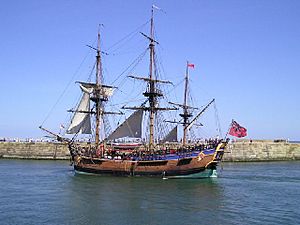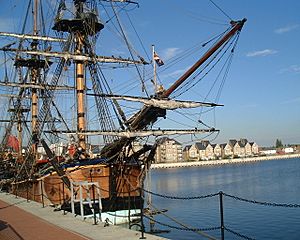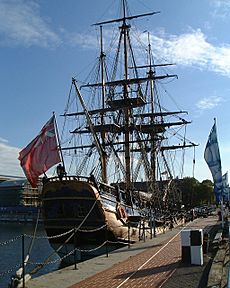HM Bark Endeavour Replica facts for kids
class="infobox " style="float: right; clear: right; width: 315px; border-spacing: 2px; text-align: left; font-size: 90%;"
|+HM Bark Endeavour Replica
| colspan="2" style="text-align: center; font-size: 90%; line-height: 1.5em;" | 
|} The HM Bark Endeavour Replica is a copy of the famous ship HMS Endeavour. This was the ship commanded by Lieutenant James Cook. He used it to explore and map New Zealand and the eastern coast of Australia.
The idea to build this replica came about in the 1980s. It was meant to be a special museum ship for the Australian National Maritime Museum. A company called Bond Corporation first offered to pay for it. They wanted to give the ship to Australia as a gift. A special shipyard was built in 1988 where people could watch the ship being made. However, the original company ran into money problems. Another company, Yoshiya Corporation, tried to help but also faced financial difficulties.
Volunteers kept the project going until 1991. That's when the HM Bark Endeavour Foundation was created. This group helped raise money to finish the ship. The Endeavour replica was launched in late 1993 and finished in 1994. After testing, it sailed from Fremantle to Sydney.
Since then, the replica has sailed many places. It recreated Cook's voyage in Australia and visited New Zealand. It even sailed around the world twice! Today, the ship is owned by the Australian National Maritime Museum. It is still active and helps people learn about history.
Contents
| History | |
|---|---|
| Name | HMS Endeavour |
| Owner |
|
| Laid down | October 1988 |
| Launched | 9 December 1993 |
| Completed | 16 April 1994 |
| Homeport | Australian National Maritime Museum, Sydney |
| Identification |
|
| Status | Active as of 2012 |
| Notes | Replica of the original HMS Endeavour |
| General characteristics | |
| Type | Bark, museum ship |
| Length | 43.6 m (143 ft), bowsprit to stern |
| Beam | 9.28 m (30.4 ft) |
| Height | 28 m (92 ft) mainmast |
| Draught | 3.4 m (11 ft) |
| Propulsion |
|
| Sail plan |
|
Building the Endeavour Replica
The idea to build a copy of the original Endeavour started with the people planning the Australian National Maritime Museum. They wanted the ship to be the main attraction of their museum ship collection.
How the Project Started
Money for building the ship was first given by the Bond Corporation. They planned to give the finished ship to Australia for its 200th birthday celebration. A special company, Endeavour Replica Pty Ltd, was set up to manage the building.
A shipyard was built at Fremantle Fishing Boat Harbour. This shipyard had a special viewing area. Visitors could watch the ship being built. Volunteers also gave tours. Building the ship was not too hard. The original Endeavour had been measured many times by the Royal Navy. These old records were kept by the British National Maritime Museum. They helped the builders make an accurate copy.
Construction Challenges
Work on the ship began in January 1988. The main frame, called the keel, was laid in October. In 1990, the Bond Corporation had to stop work. They were having money problems. A Japanese company, Yoshiya Corporation, then joined the project. But they also had to stop after six months due to financial issues.
Despite these problems, volunteers kept the shipyard running for another eight months. To finish the ship, the HM Bark Endeavour Foundation was set up in August 1991. This was a charity group. The Bond and Yoshiya Corporations gave their shares in the project to this new foundation. With money from the Australian government, loans, and donations, work on the ship continued. The Endeavour replica was launched on December 9, 1993. It was fully finished on April 16, 1994.
Materials and Design
The Endeavour replica was built using old shipbuilding methods. They used traditional materials when possible. However, some changes were made for modern safety rules. These changes also helped the replica last longer.
The ship's body, or hull, is made from jarrah wood. Oregon pine was used for parts above the waterline. The original ship used oak and elm. But these woods can rot more easily. So, the builders chose different, more durable woods. Some wood was newly cut. But much of it came from old buildings, bridges, or trees cut down during construction or storms.
The Endeavour replica has 25 sails. They are made from a strong, rot-resistant material called "Duradon." The total sail area is between 1,461 and 1,511 square meters. This includes 531 square meters of smaller sails called studding sails.
The ship is 43.6 meters long from the front (bowsprit) to the back (stern). It is 9.28 meters wide (beam). The part of the ship under the water (draught) is 3.4 meters deep. The main mast is 28 meters tall.
For extra power, the ship has two Caterpillar 3046 B diesel engines. These engines provide 404 horsepower. Most of the modern equipment, like the engines and navigation tools, are hidden. They are in what was the cargo hold on the original Endeavour. This keeps the upper decks looking just like they did in the 1700s.
Voyages and History

The Endeavour replica spent six months being tested at sea. It sailed around Fremantle before heading to Sydney. It left in October and stopped at many ports along the southern and eastern coasts. The ship arrived in Sydney in December. It was then put on display at the Australian National Maritime Museum.
Early Voyages
From April to September 1995, the replica sailed along Australia's east coast. It was following the path of the original Endeavour. Then, it visited New Zealand for three months, from November 1995 to January 1996. After that, the ship returned to Fremantle. It stopped at ports in Victoria and South Australia along the way.
In October 1996, the replica began a long journey to England. It sailed via South Africa and arrived in March 1997. It spent the rest of that year visiting British ports. In March 1998, the ship arrived in Florida, USA. It visited 31 ports along the east and west coasts of North America during 1998 and 1999. The Endeavour replica then sailed from Vancouver to New Zealand, stopping in Hawaii. It reached Wellington in late December 1999. This completed its first trip around the world! The ship stayed in New Zealand for five months before sailing back to Sydney in May 2000.
Filming and Second World Tour
In 2001, a BBC film crew came aboard the Endeavour. They filmed a documentary series called The Ship. For this, the replica recreated Cook's voyage between Cairns and Jakarta.
After a big repair job in Fremantle in late 2001 and early 2002, the replica started its second trip around the world. It sailed to Whitby, England, by going around Cape Horn. Footage of waves from this journey was used in the 2003 movie Master and Commander: The Far Side of the World. For the next two years, the ship was on display. It visited ports in the United Kingdom and Europe.
The replica left England in 2004. It returned to Australia by way of the Caribbean, the Panama Canal, the Galapagos Islands, Tahiti, and New Zealand. It arrived in Sydney at sunset on April 17, 2005. Just hours before, it had briefly run aground in Botany Bay. When it arrived, the HM Bark Endeavour Foundation gave ownership of the ship to the Australian National Maritime Museum.
In April 2011, the Endeavour began its first trip around Australia. This voyage went counter-clockwise around the continent. It ended in May 2012. The ship visited fifteen ports and sailed 13,300 nautical miles.
In October 2013, the Endeavour took part in the International Fleet Review 2013 in Sydney, Australia.
Images for kids
-
The Endeavour replica at Australian National Maritime Museum




